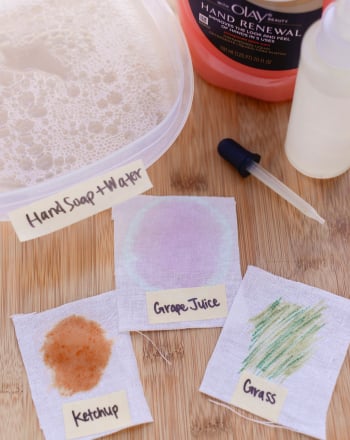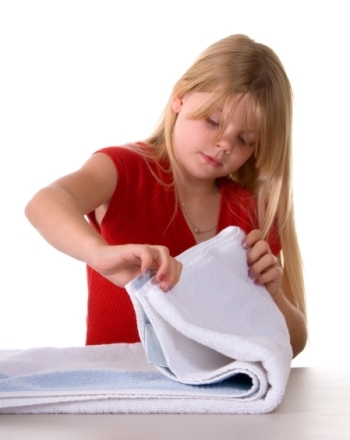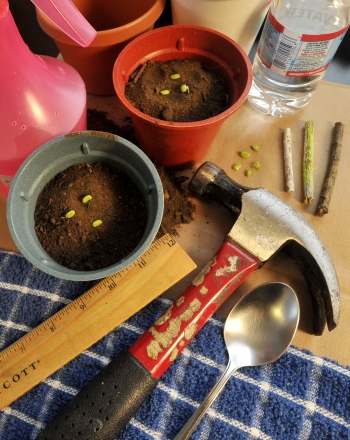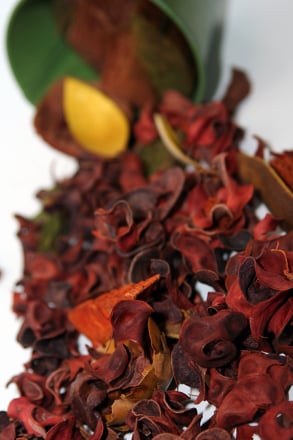Science project
最好的染色Remover for Clothes: Testing Laundry Stain Removal
Uh oh – you’ve just gotten ketchup all over your favorite white shirt. What now? Figure out what stain remover will get you out of this mess and de-stress your laundry!
Problem
Find out what household cleaner does the best job of removing stains from fabric.
Materials
- Old white socks or shirt
- Large, old towel
- Scissors
- Grape juice
- Ketchup
- Access to a patch of grass
- 3 eyedroppers
- 5 medium-sized plastic containers
- Masking tape
- Permanent marker
- 水
- Hand soap
- Bleach
- Dawn dishwashing soap
- Hydrogen peroxide
- Spray bottle
- 2 different brands of stain remover
Procedure
- To get out of a mess, you need to get into one in the first place! Cut out eighteen 2x2 inch squares from the old socks or shirt and place the cloth pieces on a table that’s easy to clean. This is the fabric that you’re going to stain.
- Lay out an old towel and use the waterproof marker to write the word “control” on a piece of masking tape, and stick it on the top left corner of the towel.
- Use one of the eyedroppers to add a few drops of grape juice to one square of the fabric.
- Use the other eyedropper to add a few drops of ketchup to a second piece.
- Rub the third control cloth on a patch of grass so that the fabric is streaked bright green.
- Line these controls underneath the “control” label.
- Using the same process, stain the other fifteen pieces of cloth (5 grape juice, 5 ketchup, and 5 grass).
- For the next set of three stained cloths (grape, ketchup, and grass), dip the fabric into a container of water, and rub in a dot of hand soap to the stain. With masking tape and a permanent marker, label this set “hand soap + water.”
- In your next set, spray the cloths with your first store-bought stain remover and label the set with the brand name.
- Repeat step 9 for the second store-bought stain remover.
- Use an eyedropper to apply three drops of bleach to the next set of stains. (Be careful! Bleach is an irritant, so make sure you wash with soap and water if you get any on your skin). Don’t forget to label!
- Next, let’s make a homemade stain remover and see how it compares. In the spray bottle, mix one tablespoon of Dawn dishwashing liquid with two tablespoons of hydrogen peroxide. Swish the mixture around a little, and spray it on your last set of stains. Add your label to the towel.
- Create a hypothesis. Which stain remover will work the best? Which one will be the least effective?
- Let the fabric dry. While it is drying, use the masking tape to label the five plastic containers with each stain remover. Fill each of these containers with about an inch of warm water.
- Leave the control on the towel – don’t put it into the water. Each of the other pieces of fabric can go into its own container of water.
- Let the pieces of fabric sit overnight, then pull them out and set them back on the towel in the morning. Let them dry again.
Are any of the pieces of fabric lighter than the others? Which stain remover is best at removing stains? Did some stain removers work well on one kind of stain, but not others?
Results
The fabric with the bleach and the homemade stain remover will be the lightest. Depending on what store-bought stain removers you used in your experiment, these will likely be runners-up. The grass stains will be the least changed.
Why?
Different cleaners clean up your mess in different ways.
Soap cleans because it is anemulsifier. It allows water to mix with other substances, such as the stains that you have on your shirt. If stains are locked onto the fabric, soap helps set them free. Soap works best in water that’s moving. They help stains come off fabric and move into the water, and this happens best in moving water (like in a laundry machine).
Bleach works differently. Bleach uses chlorine (the chemical used to keep swimming pools clean) to loosen the chemical bonds of molecules so that they have no color. Bleach doesn’t really remove the stain – it changes the ability of the molecules to absorb light and produce color. If you spill juice, jam, or ketchup on a colored shirt, bleach may not be the best solution, since it lightens the dye in the fabric also, not just the stain.
过氧化氢漂白密切相关,布鲁里溃疡t uses oxygen instead of chlorine and is safer to use on colored fabric. The homemade mixture combines the effectiveness of soap and a bleaching chemical to make a great stain remover.
Store-bought stain removers most often usesolventsthat dissolve other molecules to remove stains. Alcohol is an example of a popular solvent used in commercial stain removers. However, there are many different kinds of solvents, and each reacts differently to the various substances that cause stains. This is why some stain removers you can buy at the store may be more effective on certain kinds of stains than others.
Did you find that most of the stain removers had little effect on the grass stains? Grass stains are particularly difficult to remove because chlorophyll is apigment—aninsolublecolorant that cannot be dissolved in water. The makeup of this pigment is similar to the makeup of natural fabrics, so once they have bonded, it’s very hard to separate them again.
Education.com provides the Science Fair Project Ideas for informational purposes only. Education.com does not make any guarantee or representation regarding the Science Fair Project Ideas and is not responsible or liable for any loss or damage, directly or indirectly, caused by your use of such information. By accessing the Science Fair Project Ideas, you waive and renounce any claims against Education.com that arise thereof. In addition, your access to Education.com's website and Science Fair Project Ideas is covered by Education.com's Privacy Policy and site Terms of Use, which include limitations on Education.com's liability.
Warning is hereby given that not all Project Ideas are appropriate for all individuals or in all circumstances. Implementation of any Science Project Idea should be undertaken only in appropriate settings and with appropriate parental or other supervision. Reading and following the safety precautions of all materials used in a project is the sole responsibility of each individual. For further information, consult your state's handbook of Science Safety.












